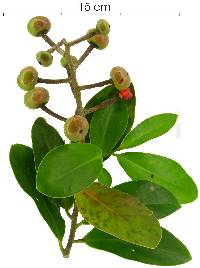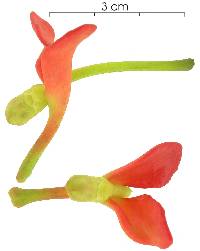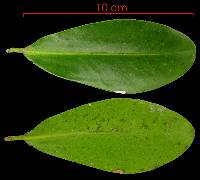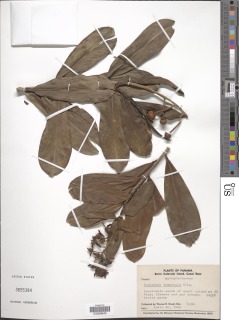

|
|
|
|
Family: Marcgraviaceae
|
Descripción: Plantas trepadoras o lianas con el tronco negro y la corteza interior roja. Las ramas jóvenes presentan raíces aéreas. Hojas simples y alternas, de 8-16 x 3-8 cm, ovadas, obovadas o lanceoladas, con ápice agudo, obtuso o acuminado, bordes enteros y base aguda o decurrente. Las hojas presentan de una a dos glándulas pequeñas en el borde cerca de la base y se tornan rojas al madurar. Pecíolo alado y de 1-1.5 cm de largo. Inflorescencias terminales. Pétalos unidos hasta más de la mitad de su longitud, pero libres apicalmente. Frutos globosos y achatados en los extremos, de 2-3 cm de ancho. Semillas cubiertas de una pulpa roja o anaranjada. Especies Parecidas: A menudo se confunde con LK marcne Marcgravia nepenthoides LK2 , pero en M. nepenthoides las hojas no se tornan rojas al madurar. También se puede confundir con plantas del género Clusia (Clusiaceae), pero Clusia tiene savia lechosa y las hojas son opuestas. S. guianensis Aubl. Hemiepiphytic, vinelike shrub, usually fastened to other vegetation with numerous, long, aerial roots; stems with papery-brown outer bark, often rooting at nodes. Petioles to 12 mm long; blades mostly obovate, rounded to obtuse at apex, acute at base, 8-14 (16) cm long, 3.5-6 (8) cm wide, thick, with 1 or 2 rows of minute glands within 1 cm of margins below. Inflorescences terminal, mostly 15-25 cm long, the continuation of an unbranched stem; pedicels 1-4 cm long, reduced near apex, densely and minutely ferruginous-pubescent; sepals 5, rounded, 2-3 mm long, very thick, imbricate, persisting; corolla greenish-yellow, to 14 mm wide, divided to basal third, broadly spreading or reflexed, rounded at apex, the lobes 5; stamens 5, alternate; anthers held above rim, 2-3 mm long, reddish; filaments about as long as thick; stigma sessile, 5-lobed, becoming soft and appearing to be receptive only after corolla has fallen, the lobes rupturing irregularly in radial pattern from center, becoming sticky; nectaries subtending flowers club-shaped, markedly auriculate, straddling pedicel, the auricles red, flattened, to ca 18 mm long. Capsules depressed-globose, 2-3 cm broad, the 5 thick valves deciduous at maturity, exposing a bright red-orange, fleshy mesocarp; seeds many, reddish-brown, sausage-shaped, 4-5 mm long, partly exposed from mesocarp. Croat 7272, 7950. Occasional, on the shore and within the forest where the branches may be found in the top of the crown. Flowers from November to July, mostly from December to March. Fruit maturity time is uncertain. In some cases the flowers never open; the apical part of the tube is removed as a calyptra before the lobes unfold. |
|
|
|
































